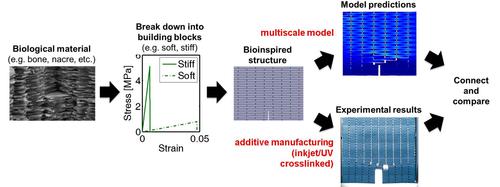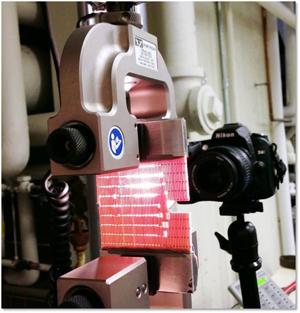MIT 3D Prints Tough, Bone-Like Composite
August 8, 2013

Printing composite materials from a 3D printer that engineers can actually use to build something may be closer than you think. A team at MIT has 3D printed bone-like composite materials on the Objet Connex500 multi-material printer. But this wasn't just any old multi-material model using the Objet polymers. They were samples printed to test a computational model the engineers had created, based on three different bone-like, biological composite structures they designed.
The structure of mineralized materials such as bone itself, as well as the structure of seashells and certain marine sponges, combines soft materials with stiff materials in complex arrangements that have superior fracture mechanical properties. We've covered similar materials before, such as the entirely new family of composites invented by ETH-Zurich materials scientists that mimic the way an abalone shell's structure aligns strong, stiff elements within a softer matrix.
Another composite modeled after a biological original is the complex fish scale architecture we told you about that could be mimicked to provide flexible composites with a hard ceramic surface for applications like body armor or prosthetic devices. That architecture's very hard exterior protects a tough, flexible internal structure that helps the scales of the Amazonian Arapaima gigas fish resist razor-sharp piranha teeth.
But using a 3D printer to print out test samples for verifying the models is a new idea. The MIT team, led by professor of civil and environmental engineering Markus Buehler, designed three different synthetic composite materials that emulate bone, bio-calcite, and a rotated bone-like geometry. All of them take advantage of the combination of stiff and soft materials typically found in composite structures, but their topologies vary. One of the project's main objectives is to show that it's possible to design materials that have specifically tailored fracture mechanical properties, using computational models, and then make those materials using 3D printing.
Click on the photo below to view an image gallery.

In an article published in Advanced Functional Materials (purchase or subscription only), Buehler and his group describe their work and the results of the tests on the samples printed on Stratasys's Objet Connex500 printer. First the team tested the two photopolymers -- the stiff Vero White Plus and the softer Tango Black Plus -- for their individual fracture response. Next, the team printed out samples of the three different materials. The deformation and fracture mechanisms of each material sample was then tested against its corresponding simulation.
Like the Amazonian fish scale architecture or abalone shell structure, the arrangement of stiff and soft materials in a hierarchical pattern in these synthetic composites dissipates energy and distributes damage over a larger area when struck. This helps the material suffer less damage from a fracture, instead of experiencing a single point of failure, since the cracks are more likely to propagate through the soft material, not the hard material that forms the object's structure.
MIT's test results showed that the fracture patterns of the bone-like material and the material with a rotated bone-like geometry performed as expected based on the computational models. The bio-calcite material was not replicated accurately during 3D printing. Increasing the feature size during printing is one way this could be addressed, the researchers wrote. Like the others, though, it performed better than its constituent materials alone.
As predicted by the simulation, the bone-like material's geometry has by far the toughest topology of the three: This material's toughness modulus is more than 20 times that of its constituent materials. The researchers conclude the article by saying their work "can potentially pave the way for more refined computational models able to predict the response of 3D-printed systems with higher accuracy as well as more complex 3D-printed structures with further improved mechanical properties."
Other members of the team that co-authored the article are graduate students Leon Dimas and Graham Bratzel, and Ido Eylon of Stratasys. The US Army Research Office provided funding.
Related posts:
About the Author(s)
You May Also Like



